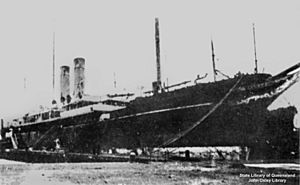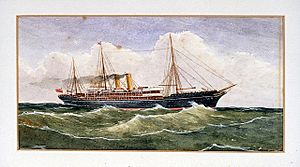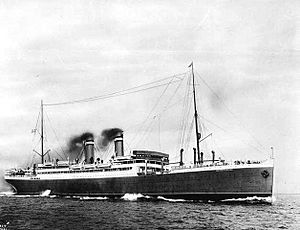RMS Atrato (1888) facts for kids

Atrato
|
|
Quick facts for kids History |
|
|---|---|
| Name | Atrato |
| Namesake | Atrato River in Colombia |
| Owner | |
| Operator | |
| Port of registry | |
| Route | Southampton – Brazil – Uruguay – Argentina (1889), Southampton – Caribbean (1889–1912) |
| Builder | Robert Napier and Sons, Govan |
| Yard number | 410 |
| Launched | 22 September 1888 |
| Renamed |
|
| Identification | UK official number 95512 |
| Fate | Sunk 13 January 1915 |
| General characteristics | |
| Type |
|
| Tonnage | 5,347 GRT, 3,069 NRT |
| Length |
|
| Beam | 50 ft (15 m) |
| Draught | 25 ft (7.6 m) |
| Depth | 33 ft 4 in (10.16 m) |
| Installed power | 1,000 hp |
| Propulsion | 1 × 3-cylinder triple expansion steam engine; single screw |
| Sail plan | 3-masted schooner |
| Speed |
|
| Boats & landing craft carried |
|
| Capacity | Passengers including 176 1st class & nearly 400 steerage. Cargo 2,524 tons |
| Complement |
|
| Notes |
|
RMS Atrato was a British steamship built in 1888. She started as a Royal Mail Ship and ocean liner for the Royal Mail Steam Packet Company. In 1912, she was sold and became a cruise ship named The Viking. Later, in 1914, she was used by the navy and became an armed merchant cruiser called HMS Viknor. Sadly, she sank in 1915, and all 295 sailors on board were lost.
Contents
Building a Big Ship: Atrato
In the 1880s, the Royal Mail Steam Packet Company (RMSP) wanted bigger ships. They needed to make their trips between Southampton, South America, and the Caribbean even better. The first new ship was the Orinoco, built in 1886. It was RMSP's first ship made of steel, not iron.
Because Orinoco was so successful, RMSP ordered two more ships. These were improved and larger versions of the design. They were built by Robert Napier and Sons in Govan, Scotland. Atrato was finished in 1888, and Magdalena followed in 1889.
Before these ships were even done, RMSP ordered two more from the same builder. These were the slightly larger Thames (1889) and Clyde (1890). All these ships were like sisters, built with similar designs.
How Atrato Was Different
The older Orinoco had only a small deck area for people. It was also the last ship for RMSP that used square sails along with its steam engine. The newer ships from Napier, like Atrato, were more modern.
They had a full deck on top for passengers. They were also rigged as a three-masted schooner, meaning they had fewer sails. This was because their steam engines were becoming more reliable and used less fuel.
Atrato's Powerful Engine
Atrato had eight boilers that created steam. This steam powered a special three-cylinder engine. This engine turned a single propeller, pushing the ship through the water.
On its test runs, Atrato could reach a top speed of 16 knots (about 30 kilometers per hour). Its usual speed for travel was 14 knots (about 26 kilometers per hour).
What Atrato Could Carry
The ship could carry many people. There were 176 first-class rooms for richer passengers. Nearly 400 other passengers, often immigrants, traveled in a cheaper area called steerage class.
Atrato could also carry a lot of goods, about 2,524 tons of cargo. It had space for 1,109 tons of coal to fuel its engine. The ship even had a refrigerated area for food, keeping it fresh. It could hold 20,000 gallons of fresh water too.
Atrato was launched on September 22, 1888. She was named after the Atrato River in Colombia. RMSP often named its ships after rivers, especially those with Spanish names, because they traded a lot with Latin America.
Atrato's Life as a Passenger Ship
Atrato's first big trip started from Southampton on January 17, 1889. She carried passengers, mail, and a full load of cargo. In her strong room, she even carried a lot of valuable items like gold coins and silver bars.
She stopped at ports like Carril, Vigo, and Lisbon. Then, she crossed the Atlantic Ocean to South America. She sailed down the east coast, stopping at places like Pernambuco, Rio de Janeiro, and Buenos Aires.
The other sister ships, Magdalena, Thames, and Clyde, joined this South American route later. But after her first trip, Atrato was moved to the Caribbean route, joining Orinoco. All five sister ships had long and successful careers.
Upgrades and Changes
Over the years, the ships received some upgrades. In 1891, their furnaces were lined with zinc to protect them from heat. In 1899, the lifeboats on Atrato and some of her sisters were moved higher up. This made them easier to launch and kept them clear of the main deck.
In 1903, Atrato and two other ships got new bronze propellers. In 1905, Atrato and Orinoco had parts of their cargo areas made into refrigerated spaces. This allowed them to carry fresh fruit.
In October 1912, a company called Viking Cruising Company bought Atrato. They renamed her The Viking. She then became a cruise ship, taking people on tours around the waters of northern Europe.
When the First World War began in 1914, the British Navy needed more ships. They took The Viking and changed her into an armed merchant cruiser. She was given the name HMS Viknor.
She was commanded by Commander EO Ballantyne. Her crew included 22 officers and 273 sailors. HMS Viknor became part of the 10th Cruiser Squadron, which patrolled the seas.
On December 28, 1914, Viknor left the River Tyne for patrol. On January 1, she joined a patrol group off the north coast of Scotland. Their mission was to find a neutral Norwegian ship, the Bergensfjord. The British government thought this ship might be carrying a German spy.
Viknor found the Bergensfjord and stopped her. She then escorted the Norwegian ship to Kirkwall in Orkney. The suspected spy and other prisoners were moved to Viknor. Then, Viknor set off for Liverpool.
The Mystery of Her Sinking
Sadly, Viknor never reached Liverpool. On January 13, 1915, she sank with everyone on board. This happened in rough seas off Tory Island, County Donegal, Ireland. She did not send any distress signals.
Later, some pieces of the ship and many bodies washed ashore on the northern coast of Ireland. It is believed that she hit a German naval mine. This mine might have been placed by a German ship called Berlin.
Her wreck was found in 2006. In 2011, a scuba diver placed a White Ensign (a flag of the Royal Navy) on the wreck. This was done to remember all the sailors who were lost.
Images for kids





